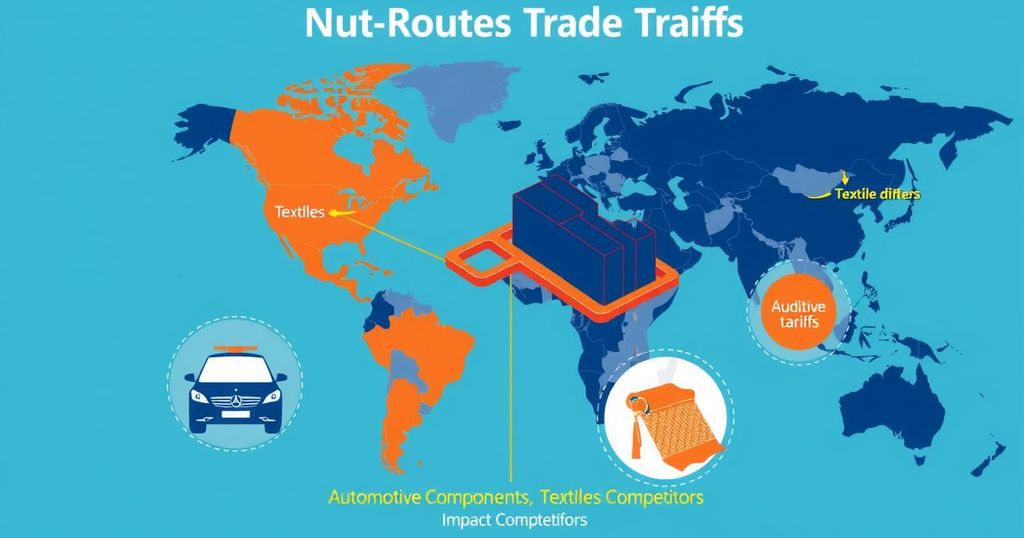Politics
AFRICA, ASIA, AUTOMOTIVE INDUSTRY, BANGLADESH, CAMBODIA, CANADA, CHINA, DONALD TRUMP, EXPORTS, FOREIGN INVESTMENT, HONDA, INDIA, INDONESIA, INTERNATIONAL TRADE, JAGUAR LAND ROVER, MEXICO, NISSAN, NORTH AMERICA, PHILIPPINES, SAUDI ARABIA, SOUTH AFRICA, SRI LANKA, SUPPLY CHAIN, TATA MOTORS, THAILAND, TRADE, UNITED STATES, US, VIETNAM
Clara Montgomery
Impact of Trump Tariffs on Indian Export Landscape: Opportunities and Challenges
India ranks as the world’s 12th-largest exporter with $441 billion in 2023, now facing a flat 27 percent tariff on exports to the U.S. This scenario poses challenges but also reveals a more favorable position compared to rivals like China (34%), Vietnam (46%), and others. Automobiles and textiles are notably affected, while some sectors may positively adjust to these tariffs. The potential for a bilateral trade agreement may offer additional pathways for relief.
In 2023, India is positioned as the world’s 12th-largest exporter, boasting total exports worth $441 billion. However, Indian exporters are currently facing a flat tariff of 27 percent on all exports to the United States. This situation presents a challenge, but India’s standing seems more favorable compared to key competitors such as China, Vietnam, Bangladesh, and Indonesia, who are all subjected to steeper tariffs.
China faces a 34 percent tariff, while Vietnam experiences an even sharper tariff of 46 percent. Bangladesh and Thailand are both subjected to a 37 percent tariff, with Cambodia facing the highest tariff rate at 49 percent, followed by Sri Lanka at 44 percent. Such comparative figures suggest a relatively advantageous trade framework for India despite the imposed tariffs.
In the automobile sector, the United States has instituted a 25 percent tariff on all imported automobiles, significantly impacting the major Asian automakers, including Toyota, Honda, and Nissan. Although India’s automobile exports to the U.S. are low—comprising only 0.13 percent in passenger vehicles and 3 percent in commercial vehicles—the new tariffs will still affect Indian firms, especially Tata Motors due to its luxury brand Jaguar Land Rover. The U.S. accounts for less than 0.5 percent of India’s total car exports, with primary markets being Saudi Arabia, South Africa, and Mexico.
The textile industry, conversely, may benefit from the new tariff arrangement, as competitors Vietnam, Bangladesh, and China are facing significantly higher duties (46 percent, 37 percent, and 34 percent respectively). As of now, India makes up 8 percent ($9.7 billion) of the U.S. textile import market, while competitors contribute smaller shares. Moreover, since textiles contribute only 2 percent to India’s GDP, in contrast to higher contributions from Bangladesh and Vietnam, India may exhibit reduced susceptibility to external economic shocks in this sector.
In the gems and jewelry sector, India remains a prominent supplier to the U.S., contributing 12.99 percent ($11.58 billion) of total U.S. imports in this category. Competing nations like France, Italy, the UAE, and Thailand have much smaller market shares, reinforcing India’s significant position in this arena. Thus, these new tariffs could impede Indian exporters more than their foreign competitors.
Agriculturally, crucial exports such as Basmati and non-Basmati rice, buffalo meat, and wheat are adversely impacted by the 27 percent tariff. Nevertheless, India may retain a pricing advantage over competitors such as China, Vietnam, Thailand, and Bangladesh in processed food items, albeit with a competitive disadvantage compared to Mexico, which benefits from lower tariffs under the USMCA.
In electronics, India exports approximately $14 billion worth of products to the U.S. The new tariffs will undoubtedly increase costs, but India is still in a better position than Vietnam and China due to their higher tariff percentages. Mexico continues to benefit from tariff-free access for compliant goods under the USMCA.
Despite these tariffs, the ongoing discussions concerning a bilateral trade agreement between India and the U.S. may potentially offer some relief. Overall, while challenges lie ahead, India is positioned to remain relatively competitive in several export sectors compared to its counterparts.
In summary, while the newly imposed 27 percent tariff on Indian exports to the United States presents significant challenges for various sectors, India finds itself in a relatively advantageous position compared to several competitors like China, Vietnam, and Bangladesh. Notably, sectors such as textiles and electronics may see some benefits, while the automotive and agricultural sectors could be adversely impacted. Strategic negotiations for a bilateral trade agreement could also possibly mitigate these new trade barriers, thereby fostering India’s export competitiveness in the future.
Original Source: www.business-standard.com








Post Comment